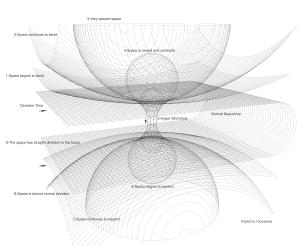Blog
Through the Wormhole
24 October 2019
 Federico Ciccarese (CC BY-SA 4.0)
Federico Ciccarese (CC BY-SA 4.0)Wormholes have long been a staple of science fiction. These theoretical shortcuts through the galaxy could let us explore the universe without all that mucking about in hyperspace. It would be great if they exist, though they probably don’t.
But what if wormholes did exist? How might we spot them? In a recent article a team looked at the theory to answer just that question.1
Within general relativity, wormholes are related to black holes. In a black hole, the matter collapses to a single point, or singularity. Once the matter enters a black hole, it is forever trapped. A wormhole has the same kind of structure on the outside, but instead of being centered on a singularity, it forms a kind of tunnel to either another region of space or another universe. When matter enters a wormhole, it would travel through the tunnel to the other side. The idea of a wormhole was first proposed by Albert Einstein and Nathan Rosen, which is why they are sometimes called an Einstein-Rosen bridge.
Because wormholes and black holes are similar, they would look the same on the outside. We see black holes all across the universe, most commonly supermassive ones in the centers of galaxies. If any of them were wormholes, it would be difficult to tell them apart from standard black holes.
But not impossible, as this new research points out. Although black holes and wormholes have the same exterior structure, wormholes can have something on the other side, whereas black holes do not. This means a star orbiting a wormhole could have an orbit slightly different from the orbit around a black hole. If there are stars on the other side of the wormhole, their gravity could tug on a star through the wormhole. This would cause the orbit of a star to deviate slightly.
The authors propose testing this idea in our galaxy. The supermassive black hole in the center of our galaxy has a nearby star called S0-2. If the supermassive black hole is a wormhole, then over time we should see S0-2 deviate in its orbit.
All of this is, of course, theoretical. Wormholes probably don’t exist. But if they do, it’s nice to know we should be able to prove it.
De-Chang Dai and Dejan Stojkovic, “Observing a wormhole” Phys. Rev. D 100, 083513 (2019) ↩︎